
Drew Hardesty
Forecaster
Is it Really LOW Danger?
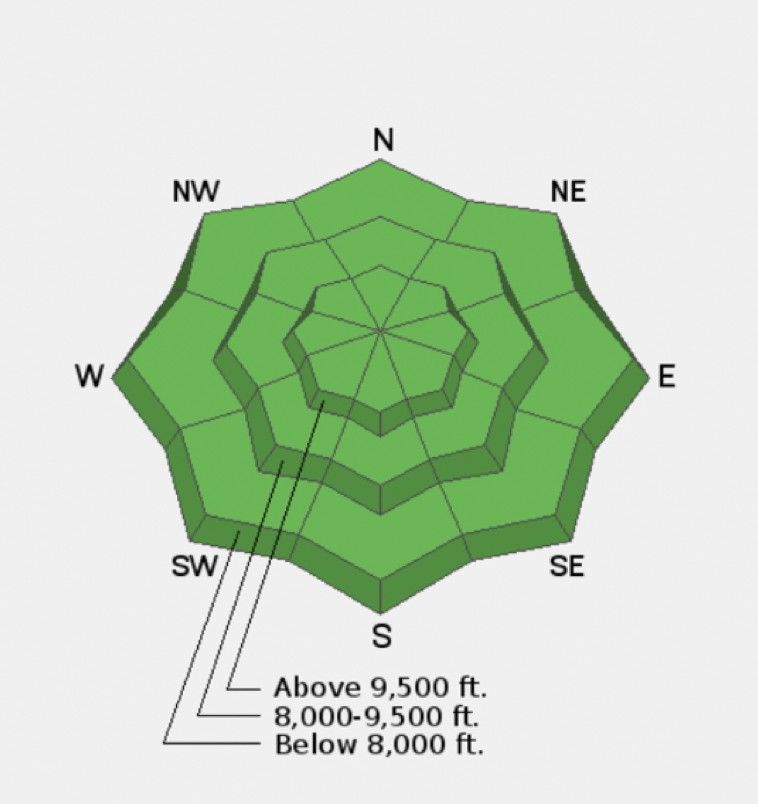
I have a unique relationship with LOW avalanche danger, especially when LOW is actually MODERATE (but that’s a different story). But there are a few things I have learned over the years about our perception and response to this rare and interesting danger rating and I'd like to share some of those with you.
But first let's back up a bit.
One of our most fundamental risk management strategies - whether we are riding the backcountry, alpine climbing, paragliding, or kayaking - is to adjust our choices (what, how, when, where, with whom) based upon conditions...and by conditions I mean weather, presence of particular hazards, and our abilities to be - well - resilient in the face of these factors.
And so it is true, then, in the backcountry, that users must choose terrain to match the avalanche conditions for the day…and it’s generally true that these (avalanche conditions and terrain choices) have an inverse relationship. (See rudimentary graph below.) The scarier the avalanche danger, the fewer terrain choices available to the savvy traveler; and vice versa: the more benign the avalanche conditions, the greater terrain options available to the backcountry skier or rider. Roger Atkins, in his seminal 2014 ISSW paper Yin, Yang, and You, attempted to standardize a “strategic mind set” for us to use as an approach to terrain as dictated by the current avalanche conditions (highly recommended reading).
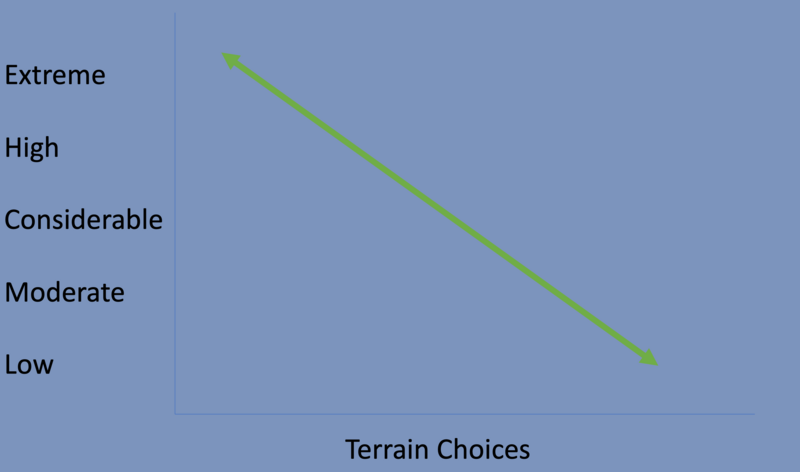
But I would argue that our perceptions and responses to LOW danger might prove that we are accepting more risk than we think or we are accepting more risk than is necessary. See the list below:
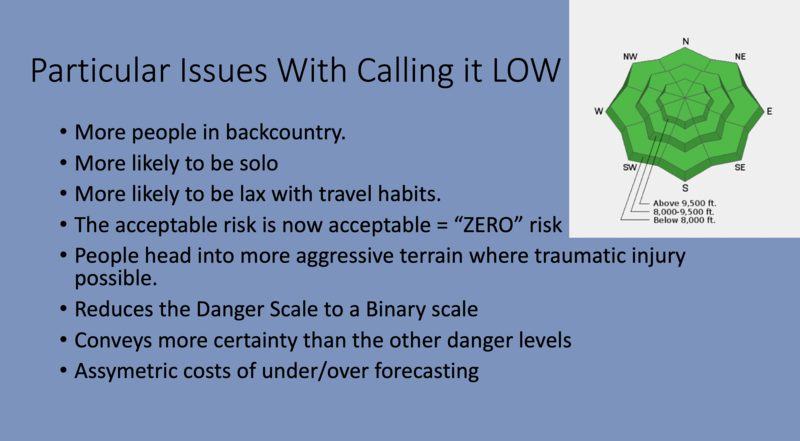
More People in the Backcountry - this is purely a numbers game. Any actuary will tell you that more drivers = more accidents. It's just a factor of time and exposure.
More Likely to be Solo - a common mindset is that if the danger is Low, then who needs a partner to dig them out of an avalanche?
More Likely to be Lax with Travel Habits - another common mindset is that we can start to cut corners and take shortcuts because there is no avalanche hazard to consider.
People Head into More Aggressive Terrain Where Traumatic Injury is Possible - and - again - this makes sense but now it only takes the most otherwise innocuous wet or dry loose sluff to knock us off our feet to go for "The Big Ride". An avalanche accident or fatality can result from either burial and/or trauma.
The Acceptable Risk is now "Acceptable" = "Zero" risk - For brevity, I'll lump this in with "Reduces the Danger Scale to a Binary Scale" and "Conveys more Certainty than Other Danger Levels". Many view the danger scale as "LOW" and everything else (binary scale) because they are uncomfortable in either their snow assessment abilities or their ability to choose appropriate terrain based upon the avalanche conditions...or.....they just don't want to assume any risk at all. In this way, a person might then assume that the risk is now 'capital A' Acceptable; ie - Zero. And this is not the case. Further, Low danger rarely carries the UNCERTAINTY and attendant language commonly found in the gray middle ground of MODERATE or CONSIDERABLE. It is also true that some people - when seeing that glowing orb of green - will stop reading (the fine print) entirely and start making their plans.
Assymetric Costs of Under/Over Forecasting - this is an essay in and of itself, but in a nutshell, one should understand that a forecast is only that: a forecast of what a person believes the avalanche danger to be for the day. Over time, if a forecaster overforecasts for a long time, she or he starts to lose credibility. If a forecaster underforecasts - maybe even once - then someone might get killed. These are clearly assymetric costs related with being wrong...and something every forecaster carries with them after their forecast shift.
See rudimentary graph below,
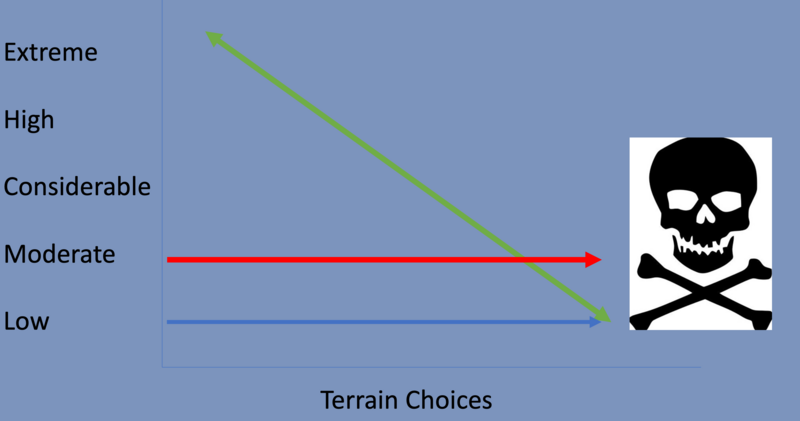
Statham, et al (2018), Techel, et al (2018), and Lazar, et al (2016) have each looked at verification and accuracy for their respective regions (Canada, Europe, USA) and - Surprise! - found that avalanche forecasts were not always accurate. A few of Statham's findings are below:
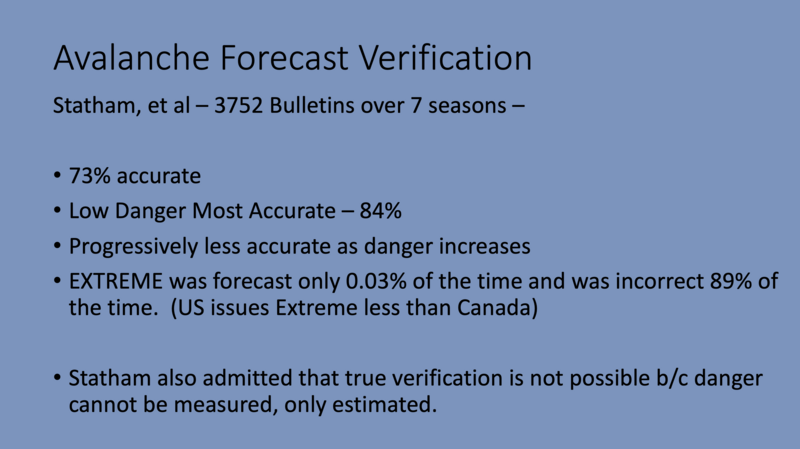
I write this because - at least in the Wasatch Range where I forecast - the avalanche danger will be trending toward LOW in the next few days. You might chew on a few of these concepts with your partners (or yourself) when getting out into the mountains.
Awesome article! Thanks Drew!
Patrick Kessler (not verified)
Fri, 3/8/2024
- reply
Going solo is, to day the least, frowned upon by the B/C community. For some, however, it's a choice between going it alone, or not going at all. Schedules, mismatched abilities, and popularity (high school never ends), are all factors that contribute to solo skiing. All said, I can't justify solo touring, but you can see why I do it. It's hard to stay away from the mountains.
Spencer (not verified)
Sat, 3/9/2024
Thanks for posting this Drew. And thanks for all the work you do!
Vlad (not verified)
Sat, 3/9/2024






